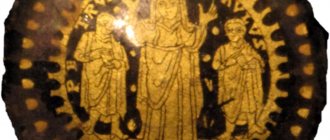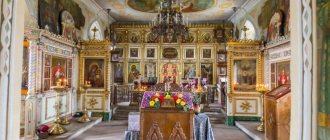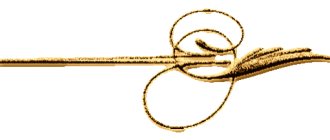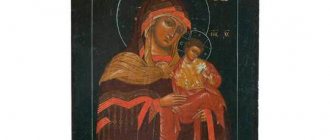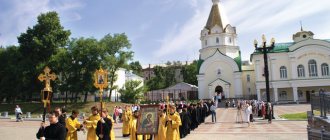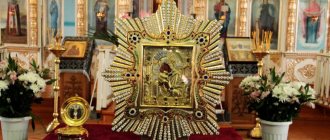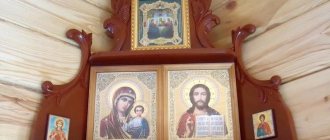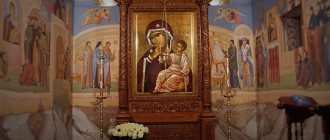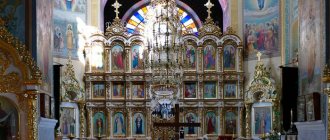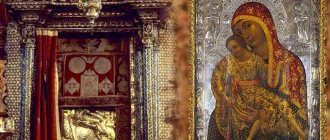The first appearance of the icon
The first Cypriot icon of the Mother of God in its most famous form was revealed in 392. This happened in the city of Larnaca in the place where Lazarus was buried. The Stavruni monastery was built on this site, and then a church was specially built, where the icon was kept. They placed it on the gates of the church, which is what the first miracle was connected with.
One day a man, an Arabian, drove past this church. What caused his action is not entirely clear; perhaps he just wanted to mock him. One way or another, he fired an arrow that hit the knee of the Virgin Mary image. Immediately a large amount of blood poured onto the ground, and after some time the man died on the way, never reaching his home.
The original icon has not survived to this day. However, in that very temple, a copy of it was preserved in mosaic form on the wall.
History of the icon
The Cyprus Icon of the Mother of God was revealed in the fourth century in Cyprus. It was located above the temple gates. One day, a certain non-believer, driving by, decided to desecrate the shrine. He shot from a bow at the image and hit the face of the Most Holy Theotokos. Immediately, quite a lot of blood flowed out of it, so that the ground under the image was covered in blood. In horror, the warrior fled, but suddenly fell and died. Such punishment befell those who did not venerate the holy icons.
This image became famous for its miracles . Lists from it quickly spread all over the world. One of them was kept by St. Sergius of Radonezh . In the fourteenth century, he founded a monastery in Staromyn and built a church in honor of the Dormition of the Mother of God. He appointed Leonty as abbot. The second abbot of the monastery was the disciple of St. Sergius Savva.
It was to him that the venerable copy of the miraculous icon of Cyprus was given to him. It was kept in the St. Nicholas Church and became famous for many miracles. The most famous of them is the healing of a seriously ill girl.
During Soviet times, the monastery was destroyed and the church closed. The miraculous icon was hidden at the home of a parishioner. It was kept there for almost thirty years, and in 1988 the church was opened, and the icon was returned to the temple. In 1996, under the chapel built on the site of the Assumption Church of the monastery, the relics of St. Sava were found.
Stromyn Icon of the Mother of God
The Cyprus Icon of the Mother of God in the village of Stromyn is one of the lists of the first image that was distributed to many Orthodox churches. It depicts the Virgin Mary sitting on a throne and holding the Child in her arms. Nearby are two holy martyrs - Antipas and Photinia.
Little is known for certain about his appearance in Rus'. According to one legend, it was with this list of icons that the abbot of the Stromynsky monastery, Savva, was blessed by Sergius of Radonezh. In 1841, the image became miraculous when an eighteen-year-old girl was healed from an illness that threatened her with death. It was this icon that the voice spoke about in the dream. At his command, she was to take the icon into the house and serve a prayer service in front of it. After doing everything, the girl was completely healed. This event led to the fact that believers began to come to the icon in crowds, asking for protection and deliverance from bodily ailments.
The days for celebrating the icon are the twenty-second of July and the first Sunday of Great Lent. In the village of Stromyn, another day is set - the sixteenth of February. It was on this day that the first healing occurred.
Honored miraculous lists
| Cyprus Icon of the Mother of God in the village of Stromyni |
Stromynsky
The most famous copy of the Cypriot icon in Russia was located in the village of Stromyn, not far from Moscow, in the Bogorodsky district. The icon measures 1 arshin and 4 inches in height, and 1 arshin and 2 inches in width. The Mother of God is depicted wearing a crown and sitting on a throne; at the top near Her there are angels on each side, one on each side, wearing crowns with branches; below are kneeling - on one side is the martyr Antipas, on the other is the martyr Photinia. About the origin of the icon, during the inquiry in 1841, it was found out that “according to church inventories, it was listed in 1783 in the abolished wooden St. Nicholas Church, behind the left choir, and in 1823 in a high place in the Sergius chapel of that church. When the St. Nicholas wooden church was dismantled in 1829, the Cyprus Icon of the Mother of God was placed on the porch of the newly built stone church above the entrance doors.” Here, in the Assumption Church, this copy of the Cypriot icon became famous in 1841.
At that time, the 18-year-old daughter of a peasant in the village of Stromyni, named Marfa, fell ill with scrofula and scrofula. The disease began to intensify over time. At the beginning of 1841, her seizures became so severe that they threatened her life. Martha's relatives and friends were already sure of her imminent death; On January 7, the sick woman was confessed and received the Holy Mysteries of Christ. But the merciful Lord did not allow her death. The Cyprus Icon of the Mother of God, standing on the porch above the entrance to their parish church, began to appear to her in a dream. From the icon, Martha heard a voice telling her: “Take Me to your house, serve a prayer service with the blessing of water, and you will be healthy.” She told her family and friends about her dreams. More than once she asked the priest and clergy about this icon, but they could not find it, since they almost never paid attention to its location. Then they brought the sick woman to the church so that she herself could find the icon she had seen. Her search for a long time was not crowned with success, until, finally, she went out onto the porch and saw an ancient icon of the Virgin Mary above the church doors. Noticing the icon, the patient joyfully exclaimed: “Here it is!” On February 16, the sick father invited a priest to his house with an icon of the Mother of God. After the prayer service with the blessing of water was served, the patient immediately felt relief. Her strength became so strong that after the prayer service she herself carried the icon of the Mother of God to the church. Soon she finally recovered.
When the residents of the village of Stromyn heard about the miraculous healing, they began to come to the church in large numbers to serve prayers before the famous icon. Graceful power emanated from her and healed those who, with humility and hope for the intercession of the Mother of God before God, brought their prayers to her. Not only parishioners of the village of Stromyni, but also residents of the surrounding areas began to flock here. Healings of paralysis and relaxation have been witnessed.
The priest of the Assumption Church reported all these miracles and the popular veneration of the icon to the Moscow Metropolitan, Saint Philaret, who ordered that a search be made about the image, place the icon in a decent place, not prohibit prayer services, and report weekly on the events taking place. In the winter and autumn of 1841, the flow of people to the icon began to decrease and Metropolitan Philaret ordered the local dean to stop weekly reports, excluding special cases. Since then, the Cyprus-Stromynsk Icon of the Mother of God remained in its place, and through prayers miraculous help continued to be given to it for those who came with sincere faith. The icon was decorated with a rich silver-gilded chasuble. In the church of the village of Stromyn, this icon was also celebrated on February 16 - the day of the healing of the maiden Martha.
Nizhny Novgorod
Celebration of May 12
The Mother of God is depicted sitting on a throne; Her head is decorated with a royal crown. The Eternal Child is represented with his head uncovered, while His right hand blesses.
The Cyprus Icon of the Mother of God, located in Nizhny Novgorod in the Church of St. John the Baptist, which became famous for many miracles in Slobodka. Through prayers before her, the pestilence in Nizhny Novgorod, which raged there in 1771, stopped. Residents of the city took the holy icon into their homes, performed prayer services in front of it and received healings.
Other lists
In Russia, there are also known copies of the Cyprus Icon of the Mother of God located in the Moscow Church of St. Nicholas in Golutvin and in the Moscow Assumption Cathedral near the left pillar. The latter depicts the Mother of God with the Eternal Child, and below is an orb; This icon was decorated with a rich frame.
Other lists of Cypriot icons
The Cyprus Icon of the Mother of God has other lists. By the way, they may differ in their spelling, but they will all have the same name. For example, there are lists where the Mother of God does not sit on the throne, but on the sides are Peter of Athos and Onuphrius the Great. In some images the Child holds a scepter in his hands. Another version of the image, also common, is where the Mother of God sits on a throne and the Child is in her arms. There are angels with palm branches around.
So, one of the lists is located in Nizhny Novgorod and became famous for many miracles. In this icon, the Mother of God is depicted sitting on a throne, wearing a crown on her head. The Baby sits in his arms, blessing with his right hand. His head is uncovered.
Another list is located in Moscow, in Golutvin, in the Church of St. Nicholas. And the last, quite famous similar image can also be found in Moscow, in the Assumption Cathedral. It depicts the Virgin Mary and Child, with an orb below.
In addition, some ancient copies of the icon can be found in Russian museums, which are kept there as the greatest shrines.
Two Sava and two Dubno monasteries
The second shrine of the Assumption Church in the village of Stromyn is the relics of St. Savva of Stromyn, a disciple of Sergius of Radonezh. Previously, they rested under cover in a stone chapel at the Stromynsky cemetery, six hundred meters from the temple, but in 1996 the ashes of the saint were transferred to the Assumption Church and placed in a gilded shrine. The stone chapel of Savva Stromynsky remained standing in the cemetery, although the entrance to it is closed.
Before the secularization of church lands by Catherine II, the Assumption Dubensky Monastery was located in Stromyn. It was founded at the end of the 14th century at the request of Grand Duke Dmitry Donskoy by the Monk Sergius of Radonezh. The monastery was named after the local river Dubenka. The prince and the Trinity Abbot erected the Dubensky Monastery in gratitude to the Most Holy Theotokos for the victory over Mamai in the Battle of Kulikovo. This is a rare case when a monastery, founded by Sergius of Radonezh himself and in honor of such an important historical event, became impoverished centuries later and disappeared. Since the 18th century, the churches of the former monastery were converted into parish churches. In the 19th century, instead of wooden churches, the current Assumption Church with chapels of St. Nicholas the Wonderworker and St. Sergius of Radonezh was erected.
In 1859, historian Mikhail Vladimirovich Tolstoy discovered the remains of another Assumption Monastery on another river, Dubenka. There were strange discrepancies in different editions of the life of St. Sergius and the chronicles. For example, in one place the foundation of the monastery was attributed to the period after the victory over Mamai in 1380, in another – to the time before the Battle of Kulikovo. The founders of the Dubno monastery were named either St. Savva or Leonty. M.V. Tolstoy suggested that the confusion arose due to the fact that Sergius of Radonezh founded two monasteries with almost the same name: Dubensky Stromynsky and Dubensky Shavykinsky.
The second Dubensky monastery was located in the Alexander district on the border of the Vladimir and Tver provinces on an island surrounded by four rivers: Dubnaya, Dubenka, Vytraska and Bystritsa. In the summer of 1859, Tolstoy went in a shuttle to a marshy island to the Shavykina Heath - a place where, according to the stories of old-timers, traces of the Dubno Monastery remained. He wrote: “On a hill near the bank of the Bystritsa River, under the shadow of centuries-old pines, traces of ridges, a dried-up pond, several graves overgrown with grass, and two chapels on the site of former temples are visible.” In the neighboring churchyard of the Savior for Kubezhye, Tolstoy found the church where the altar Gospel, the cross, the censer and the Iveron Icon from the former Dubno Monastery were kept. At that time, during Great Lent, the Iveron Icon was carried with a religious procession to Shavykino “to one’s home” in memory of the disappeared monastery. In another village of Zabolotye, Tolstoy found an icon of the Savior with the inscription: “came from the former Assumption Savvin and Serapion Monastery in Shavykino.”
Both disappeared Assumption monasteries stood on rivers with the same name and had two namesake abbots from among the close disciples of Sergius of Radonezh. According to M.V. Tolstoy, these were two different people. In a village near Moscow, Savva Stromynsky was revered, and in Shavykino, Savva Storozhevsky was revered. After becoming abbess at the Dubensky monastery, he left for Zvenigorod and became famous as the founder of this monastery near Moscow.
How to pray to an icon?
You should know that there is no such thing as a special akathist to the Cyprus Icon of the Mother of God. If you want to pray in front of the image, then you can read any troparion, kontakion or prayer address from another icon of the Mother of God. It won't be a mistake. There are also two special prayers for this icon, as well as its magnification.
However, if you want to find an akathist - a canon of the icon of the Mother of God of Cyprus, then in principle you can use the one that is read before all such images.
Where to hang
According to church traditions, icons should be located on the eastern side of the house. But this does not always happen, because it happens that a house or apartment does not have living quarters on this side of the world. Then the iconostasis is placed in a different place. It is important to choose the most honorable place. In addition, the chosen wall should be accessible and free from other objects. Nothing should distract attention for prayer. Therefore, you should not place any decorative items, paintings, or bright objects next to the icon.
- Icon in the living room.
To decorate the image of the Mother of God of Cyprus, as well as other icons, it is allowed to decorate it with embroidered towels and beautiful candlesticks.
Do not neglect fire safety rules. Therefore, it is better to keep candles at a safe distance from icons and objects that are easily ignited by open fire. Therefore, it is better to use lamps in the house during prayer.
If a family has a tradition of praying together, it is important to ensure that everyone has enough space to sit freely in front of the icon. Everyone should see the image well and could cross themselves without difficulty.
It happens that in a cramped home, it is problematic to allocate a free wall for prayer. Then the icon can be installed on a table or windowsill. In this case, if there are foreign objects nearby, it is better to remove them during prayer. When this is difficult to do, then you should cover them so that nothing interferes with your concentration.
In the case where the icon is in the kitchen, it is important to install it so that there are no household appliances, kitchen utensils or other foreign objects nearby.
When there is a need to place an icon in the room of a seriously ill person with limited mobility, you should choose a place so that he can always see the image. It is worth remembering that the Cyprus Icon of the Mother of God repeatedly healed from various ailments, including paralysis. Even if the patient cannot cross himself, sincere prayer, even mental prayer, will help recovery.
Icon of the Mother of God “Merciful” (Kykkos)
The most famous Cypriot icon of the Mother of God in Cyprus today is the image of the “Merciful One”. This is an ancient image that was written by Luke. Today the icon is in the imperial monastery. It was there that a temple was erected in her honor.
Now the image is closed so that the faces are not visible. However, this does not detract from her miraculous abilities. Even people of other faiths turn to her for help, and grace descends upon everyone.
Many copies have been written from the Kykkos icon, which are found in many places today. For example, it is in Thessaloniki, in the Church of the Icon of Our Lady “Gum”. It is also available in Russia. One is located in the St. Nicholas Convent, another in the Conception Monastery in Moscow. Remembrance days fall on the twelfth of November and the twenty-sixth of December.
What does the icon protect from?
The icon of the Cyprus Mother of God is one of the most powerful miraculous images in Orthodoxy.
Prayers are addressed to her
- About the recovery of people with serious illnesses, in particular those who are paralyzed. Also, about the healing of diseases that medicine considers incurable.
- To stop the epidemic or prevent its spread. Since ancient times, people prayed in front of the icon during plague, pestilence, and cholera.
Also, they pray to the icon if a difficult life situation has arisen in the family, for the health and well-being of their relatives and friends.
Miracles performed near icons
All of the icons listed are miraculous. Of course, events were not always recorded, but some of them still survived. For example, those miracles that took place near the Stromynsk icon were recorded. The very first was the miracle of the girl’s healing, which is described above.
Another event was the complete recovery of the peasant Alexei Porfiryev, who had been suffering from paralysis for a long time, completely losing his mobility. After the prayer service near the icon, he regained his former mobility and was able to continue to live fully.
Such healings have happened more than once. It was with motor problems that the power of the icon was most clearly manifested. According to the chronicles, this happened at least two more times, when the believers were completely cured from the relaxation of their arms and legs.
A very great healing happened with another list. By prayers to the Cypriot icon, which is located in Nizhny Novgorod, in 1771 the invasion of the pestilence epidemic, which claimed many lives, was stopped. Many healings also occurred thanks to her help. At that time, the icon moved from house to house, where people performed prayer services in front of it. This is how numerous healings took place.
The miracles of the Kykkos Icon are no less significant. They were first mentioned at the time when the icon was moving to Constantinople, since, despite numerous attacks, it arrived safe and sound at its destination. However, in the twelfth century it was transported to Cyprus. This was preceded by a chain of amazing events. The ruler of Cyprus was punished with paralysis for beating an old man in anger. Subsequently, he repented, and the elder told him about his vision. The ruler was supposed to bring an icon of the Mother of God from Constantinople to Cyprus. Having set out on his journey, he found the emperor's daughter in the same condition as him. This was a sign. The icon was taken and brought to the island, where it continued to perform its miracles.
